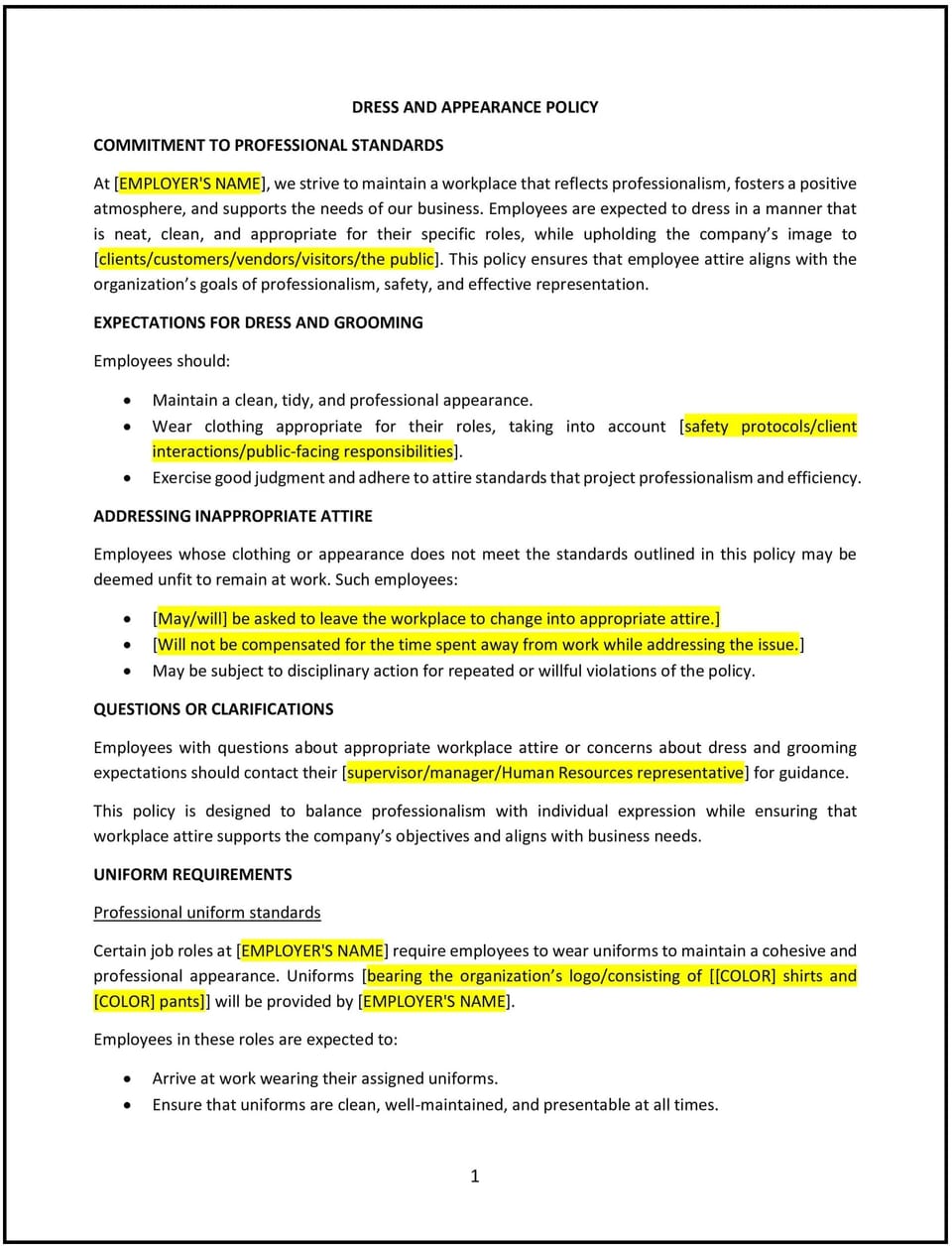Dress and appearance policy (Idaho): Free template

Dress and appearance policy (Idaho)
A dress and appearance policy helps Idaho businesses establish guidelines for employee attire and grooming to maintain a professional and safe work environment. This policy outlines acceptable dress codes, grooming standards, and any exceptions for specific roles or situations. It reflects the business’s commitment to professionalism, safety, and alignment with industry standards.
By implementing this policy, businesses can promote a positive workplace culture, ensure safety, and present a consistent image to clients and customers.
How to use this dress and appearance policy (Idaho)
- Define dress code categories: Specify the types of dress codes applicable to the workplace, such as business formal, business casual, or uniforms.
- Outline grooming standards: Provide guidelines for personal grooming, including hygiene, hairstyles, and accessories, to ensure a neat and professional appearance.
- Address safety requirements: Include dress and appearance guidelines for roles that require specific safety gear, such as protective clothing or closed-toe shoes.
- Specify exceptions: Outline any exceptions to the dress code, such as casual Fridays, themed events, or accommodations for religious or medical reasons.
- Communicate expectations: Ensure employees understand the policy, including any consequences for non-compliance, during onboarding and through regular reminders.
- Train managers: Equip supervisors with the knowledge to enforce the policy consistently and address any issues professionally.
- Review and update: Regularly review the policy to ensure it remains aligned with workplace trends, safety standards, and Idaho laws.
Benefits of using this dress and appearance policy (Idaho)
This policy provides numerous benefits for Idaho businesses:
- Promotes professionalism: A clear dress code helps employees present a polished and professional image to clients, customers, and colleagues.
- Ensures safety: Guidelines for safety gear and appropriate attire reduce the risk of workplace accidents or injuries.
- Supports workplace culture: A consistent dress code fosters a sense of unity and professionalism among employees.
- Enhances brand image: Employees who adhere to the dress code reflect positively on the business’s brand and reputation.
- Provides clarity: A well-defined policy ensures consistent expectations for all employees and reduces potential misunderstandings.
- Encourages inclusivity: The policy should accommodate religious, cultural, or medical needs, promoting a respectful and inclusive workplace.
- Aligns with industry standards: The policy helps businesses meet expectations for professionalism and safety in their industry.
Tips for using this dress and appearance policy (Idaho)
- Communicate the policy effectively: Share the policy with employees during onboarding, training sessions, and through internal communications to ensure awareness.
- Provide examples: Include visual examples or descriptions of acceptable attire to help employees understand the expectations.
- Train managers: Ensure supervisors understand the policy and are equipped to enforce it consistently and professionally.
- Address exceptions: Be prepared to handle requests for exceptions, such as accommodations for religious or medical reasons, with sensitivity and fairness.
- Monitor compliance: Regularly review employee adherence to the policy and address any issues promptly.
- Review the policy regularly: Update the policy as needed to reflect changes in workplace trends, safety standards, or Idaho laws.
- Lead by example: Encourage leadership to model adherence to the dress code and demonstrate a commitment to professionalism.
Q: Why should Idaho businesses have a dress and appearance policy?
A: A dress and appearance policy helps businesses maintain a professional and safe work environment, promote a positive workplace culture, and present a consistent image to clients and customers.
Q: What types of dress codes should businesses consider?
A: Businesses should consider dress codes such as business formal, business casual, or uniforms, depending on the workplace environment and industry standards.
Q: How should businesses address safety requirements in the policy?
A: The policy should include guidelines for safety gear, such as protective clothing or closed-toe shoes, for roles that require specific safety measures.
Q: Are there exceptions to the dress code?
A: Businesses should outline exceptions, such as casual Fridays, themed events, or accommodations for religious or medical reasons, in the policy.
Q: How should employees request accommodations for dress or appearance?
A: Employees should follow the procedures outlined in the policy, including notifying their supervisor and providing any required documentation.
Q: What happens if an employee violates the dress code?
A: The policy should outline disciplinary actions for non-compliance, such as verbal warnings or written notices, depending on the severity of the violation.
Q: How often should the policy be reviewed?
A: The policy should be reviewed annually or as needed to reflect changes in workplace trends, safety standards, or Idaho laws.
This article contains general legal information and does not contain legal advice. Cobrief is not a law firm or a substitute for an attorney or law firm. The law is complex and changes often. For legal advice, please ask a lawyer.


